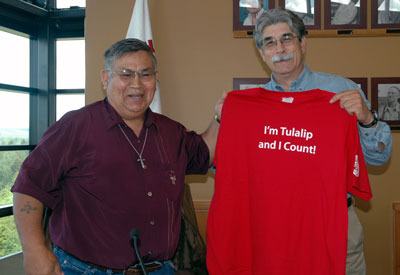TULALIP — The Tulalip Tribes are bucking national trends in their rate of response to the 2010 Census, and Tribal members and Census workers came together June 3 to celebrate the efforts of those who have contributed to these results.
Tulalip Tribal Chair Mel Sheldon Jr. opened the meeting in the Tribal Boardroom by noting that 93 percent of Tribal and non-Tribal residents of the Tulalip Reservation have already been counted in this year’s census. This represents a huge increase from the 54 percent reporting rate for the 2000 Census of reservation residents. Census Regional Manager Jan McStay, who oversees five states, added that the national average is closer to 73 percent.
Tulalip Tribal Board member Don Hatch Jr. laughed as Sheldon handed him a T-shirt that said “I’m Tulalip and I Count!” Hatch had almost been counted twice during this year’s census, which his fellow Board members teased him about, and he joined Sheldon and Tribal Board Secretary Marie Zackuse in praising the nearly 50 Tribal members and employees, as well as Tulalip residents, who have been conducting this year’s census on the reservation.
Tribal Vice Chair Marlin Fryberg Jr. emphasized the importance of explaining to young people why they need to be counted in the census, which Tribal Board Treasurer Chuck James agreed with from an economic perspective.
“I’ve spent most of my life making sure that money is spent in the right ways,” James said. “An accurate count on the census ensures that federal money is spent in the right places, and in the right amounts.”
Sheldon elaborated that census results determine how much federal money goes to the Tulalip community for employment, housing, transportation infrastructure and youth programs such as the Tulalip Boys & Girls Club.
Tulalip Government General Manager Shelly Lacy thanked those who conducted this year’s census for their dedication to their jobs, which Tribal Board member Glen Gobin echoed.
“Native people have a habit of not wanting to fill out government papers,” Gobin laughed, before addressing the census workers more seriously. “To increase the rate of response by this amazing amount, you’re not just doing this for a paycheck. You really believe in what you’re doing.”
McStay acknowledged that mistrust of government and language barriers have traditionally been obstacles in obtaining accurate census counts among Native Americans. She praised the leaders of the Tulalip government and community for raising awareness of the census and promoting cooperation with its workers, in part by working to include members of the Tulalip community in the census teams.
“This is the best example of teamwork I’ve seen in my five states, or even heard of nationwide,” McStay said. “From your media outreach to your census workers’ uniforms, you made the census fun. I plan to showcase the Tulalip Tribes’ efforts as a model for the rest of the country.”
Leland Dart of the Everett Census Bureau likewise praised the Tulalip Census for setting an instructive example for tribal and non-tribal populations alike.
The Tribal Board spent $15,000 on a marketing campaign whose earlier events began during the summer of last year, culminating in a March 31 “census party” in the reservation’s gymnasium, shortly after census forms were mailed, where the price of admission was a completed census form. The event attracted an estimated attendance of 500, and the Muckleshoot and Quinault tribes staged similar census parties within the weeks the followed.
Tribal outreach efforts included mass postal and electronic mailings, flyers, posters, reminder notices in Tribal employee paycheck envelopes and heavy promotion in the See-Yaht-Sub newspaper and on KANU TV Channel 99. Tribal members posed for the posters’ photos. Census information centers also opened on the reservation, between mid-March and mid-April, to assist residents in completing their forms. An estimated 70 percent of reservation residents returned their forms without being contacted by census canvassers.
The June 3 ceremonies concluded with McStay presenting Sheldon with a certificate of appreciation in recognition of the Tulalip Tribes’ efforts, followed by Tulalip Tribes Public Affairs Coordinator Mytyl Hernandez and Governmental Affairs Director Theresa Sheldon wrapping McStay in a blanket as a Tribal commendation.
Census workers are still going door-to-door through the month of June.



